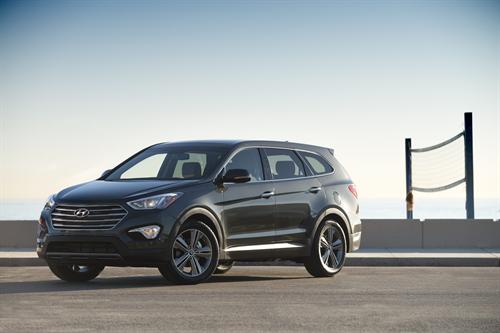 COSTA MESA, Calif., July 31, 2013 – Since the moment it rocked the automotive world at its introduction in September 2000, Hyundai’s Santa Fe has been a powerful player in the crossover segment. That momentum continues, with two all-new models leading the charge to a retail sales growth rate exceeding 40 percent through June, highlighted today by the sale of the one millionth Santa Fe in the United States.
COSTA MESA, Calif., July 31, 2013 – Since the moment it rocked the automotive world at its introduction in September 2000, Hyundai’s Santa Fe has been a powerful player in the crossover segment. That momentum continues, with two all-new models leading the charge to a retail sales growth rate exceeding 40 percent through June, highlighted today by the sale of the one millionth Santa Fe in the United States.
“When the 2001 Santa Fe launched in the United States 13 years ago, not only was it Hyundai’s first SUV, but it was one of the first compact crossovers on the market – just behind Toyota RAV4 and Honda CRV,” said John Krafcik, president and CEO of Hyundai Motor America. “It was a bold move that paid off and helped position Hyundai as a brand that could innovate in design and package, not just value and warranty.”
Prior to Santa Fe’s arrival in the U.S., Hyundai was known primarily for building inexpensive compact cars. Santa Fe opened doors to an entire new group of car buyers and offered them a new choice in the small crossover class. Entering the market with distinctive design, great equipment and backed by industry leading quality, Santa Fe soon became one of the best-selling crossovers in the industry.
Fast forward to today, and the third-generation Santa Fe continues this trail-blazing narrative as the first U.S.-market crossover with a two-wheelbase strategy – the two-row, five-passenger Santa Fe Sport and the long wheelbase three-row, six/seven passenger Santa Fe – offering Hyundai buyers vehicle choices they can grow with through various life stages (pre-family, family, post family).
“Santa Fe has played a significant role in Hyundai’s success and growth in the United States,” Krafcik adds. “For many loyal Hyundai owners today, it was their entry point to the brand.”
The Santa Fe is an award winner and has been right from the start. From being top-rated in the 2001’s Vehicle Satisfaction Index from Auto Pacific, the first time a Korean brand vehicle lead in a satisfaction category, to being named in U.S. News and World Report the “Best 3-Row Midsize SUV” and “2013 Best Car for the Money.”
Santa Fe has deep American roots with assembly today taking place in West Point, Georgia, where the majority of Santa Fes are now produced. Previously, Santa Fe was built at Hyundai Motor Manufacturing in Montgomery, Alabama, where today Sonata and Elantra are built. This year, Hyundai will make nearly 500,000 vehicles in the U.S., and sell over 700,000 vehicles here, a remarkably high ratio of U.S. production to U.S. sales. For a historical look at Santa Fe,
TWO MILLIONTH HYUNDAI ROLLS THROUGH PORT, FACILITY EXPANSION UNDERWAY
PORTLAND, July 23, 2013 – It was 1990 when the Hyundai import auto terminal first opened in Portland – the same year the world’s first web server created the foundation of what is now the Internet. Much has changed since then, and just like the web, the look and performance of Hyundai vehicles has evolved.
Now 23 years later, the two millionth Hyundai arrived at the port in July. Growing volumes of Hyundai vehicles have helped keep Portland the second largest auto import hub on the U.S. West Coast.
Hyundai Motor Company first began importing cars through Portland in 1986 – mostly Excel subcompact automobiles bound for dealers in 29 states. In 1988, Hyundai Motor America signed a letter of intent confirming that the Port of Portland was selected as Hyundai’s primary U.S. port of entry. Support from the Governor’s office and federal delegation helped secure the commitment.
“Hyundai did an extensive comparative analysis on various West Coast ports for more than a year before finally deciding to anchor down in Portland,” said Bob Mazer, manager, Portland of GLOVIS America, Hyundai Auto Group’s logistics provider.
Construction of a $12.2 million auto import facility and floating dock was financed by the port, Oregon Lottery funds and Hyundai. At a memorable groundbreaking ceremony in June 1989, skydivers delivered a shovel from 2,000 feet. As a symbol of the friendly ties and growing trade between Oregon and South Korea, they displayed the flags of each country as they floated down to Hyundai’s construction site. The first Hyundai auto ship called the new facility in March 1990.
“Hyundai’s volumes have grown over the past two decades, we have continued to grow with them,” said John Akre, terminal manager for the Port of Portland. “We have always had a great relationship with Hyundai and GLOVIS.”
A few long-term leases and two million cars later, Auto Warehousing Company now handles the inbound Hyundai vehicles for GLOVIS at the leased, 130-acre Terminal 6 auto processing facility. A $2.8 million expansion is underway to expand the processing building by 27,000 square feet and increase capacity to more than 110,000 vehicles annually. This could double the 70 jobs already on site, and provide added work for rail, trucking, longshoreman and Teamster workers.
Portland saw more than 275,000 vehicles roll across the docks in 2012, and each one has an estimated economic impact of $271 to the local economy.
